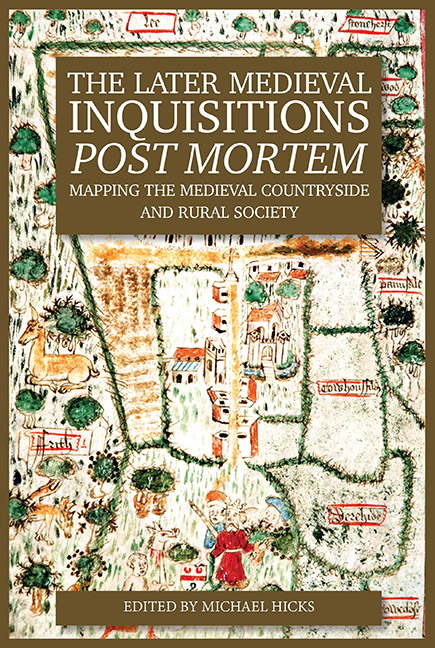Book contents
- Frontmatter
- Contents
- List of Illustrations
- List of Contributors
- Glossary
- List of Abbreviations
- 1 Introduction
- 2 Records of an Imperial Administration? Inquisitions Post Mortem in Scotland and Calais
- 3 Inquisitions Post Mortem in Medieval Ireland
- 4 The Court of the Honour of Clare, 1308–60: Feudal Incidents and Inquisitions
- 5 Landscape, Farming and Society in an English Region: The Inquisitions Post Mortem for the West Midlands, 1250–1509
- 6 Beyond the Dots: Mapping Meaning in the Later Medieval Landscape
- 7 Fairs and Markets in the Inquisitions Post Mortem
- 8 The Structure of the Milling Industry 1427–37
- 9 Proofs of Age 1246 to 1430: Their Nature, Veracity and Use as Sources
- 10 What Went On in the Medieval Parish Church, 1377–1447, with Particular Reference to Churching
- 11 Retainers, Monks and Wine: Three Insights into Everyday Life
- 12 The Administration and Efficiency of the Inquisitions Post Mortem Process: A Case Study of Northumberland
- 13 Late Medieval Land Disputes and the Manipulation of the Inquisitions Post Mortem
- Index
8 - The Structure of the Milling Industry 1427–37
Published online by Cambridge University Press: 26 May 2021
- Frontmatter
- Contents
- List of Illustrations
- List of Contributors
- Glossary
- List of Abbreviations
- 1 Introduction
- 2 Records of an Imperial Administration? Inquisitions Post Mortem in Scotland and Calais
- 3 Inquisitions Post Mortem in Medieval Ireland
- 4 The Court of the Honour of Clare, 1308–60: Feudal Incidents and Inquisitions
- 5 Landscape, Farming and Society in an English Region: The Inquisitions Post Mortem for the West Midlands, 1250–1509
- 6 Beyond the Dots: Mapping Meaning in the Later Medieval Landscape
- 7 Fairs and Markets in the Inquisitions Post Mortem
- 8 The Structure of the Milling Industry 1427–37
- 9 Proofs of Age 1246 to 1430: Their Nature, Veracity and Use as Sources
- 10 What Went On in the Medieval Parish Church, 1377–1447, with Particular Reference to Churching
- 11 Retainers, Monks and Wine: Three Insights into Everyday Life
- 12 The Administration and Efficiency of the Inquisitions Post Mortem Process: A Case Study of Northumberland
- 13 Late Medieval Land Disputes and the Manipulation of the Inquisitions Post Mortem
- Index
Summary
In 2006 Bruce Campbell and Ken Bartley brought out England on the Eve of the Black Death: an Atlas of Lay Lordship, Land and Wealth, 1300–49. This magnificently detailed analysis of the rural economy in the first half of the fourteenth century used data from the manorial extents contained in IPMs to produce distribution maps and statistics of land use and land values, agriculture, estate and social structure, and other aspects of rural society. It is sometimes said that a similarly detailed analysis cannot be produced for subsequent periods of the late Middle Ages because from the middle of the fourteenth century onwards the extents contained in IPMs become ever less detailed. This is partly true – the later IPMs do indeed lack some of the detailed lists of manorial assets which are numerous before c.1350, primarily those of crops and livestock. But nevertheless they often do provide aggregate data for these assets (for example, the total areas of arable, pasture, meadow and woodland within a manor and their values per acre, or the respective total rents received from its free and customary tenants), and some use can be made of these. In some other categories they provide data nearly as full as those to be found in the pre-1350 IPMs. This paper tests the possibilities through a case study of one type of manorial asset: mills.
Mills are dealt with in Chapter 16 of the Atlas. Its 20 pages contain 24 distribution maps and eight graphs analysing the numbers and types of mills and their geographic distributions and values, broken down by power source, function, physical condition and other factors. There is not space here to attempt to duplicate every analysis featured in the Atlas, but its major aspects will be covered.
The Atlas deals with mills only in the half century before 1350. Two monographs on the milling industry have also been published which cover the later Middle Ages after 1350. Richard Holt's The Mills of Medieval England covered the entire period from Domesday Book to c.1500, while John Langdon's Mills in the Medieval Economy focused on the two and a half centuries after 1300.
- Type
- Chapter
- Information
- The Later Medieval Inquisitions Post MortemMapping the Medieval Countryside and Rural Society, pp. 115 - 135Publisher: Boydell & BrewerPrint publication year: 2016
- 1
- Cited by

